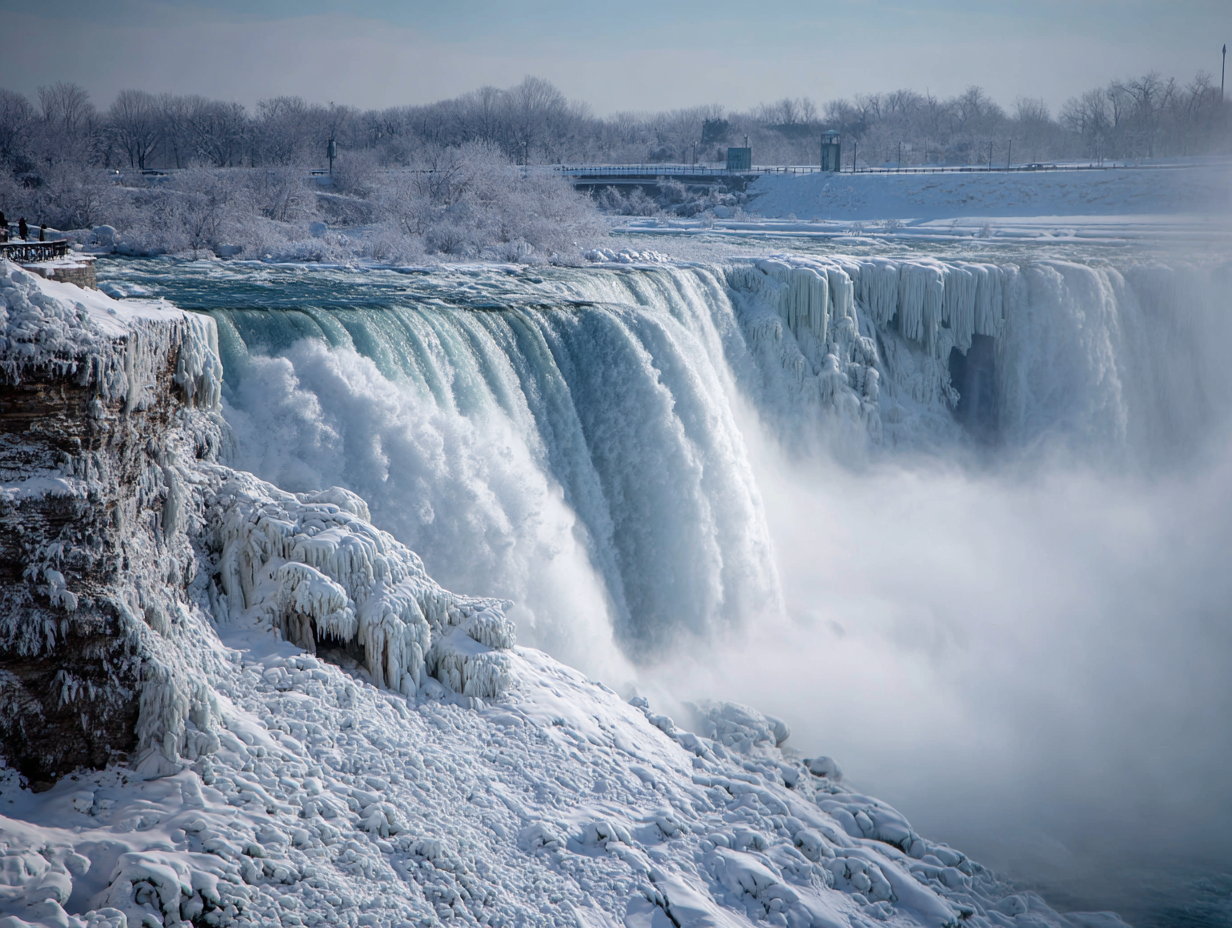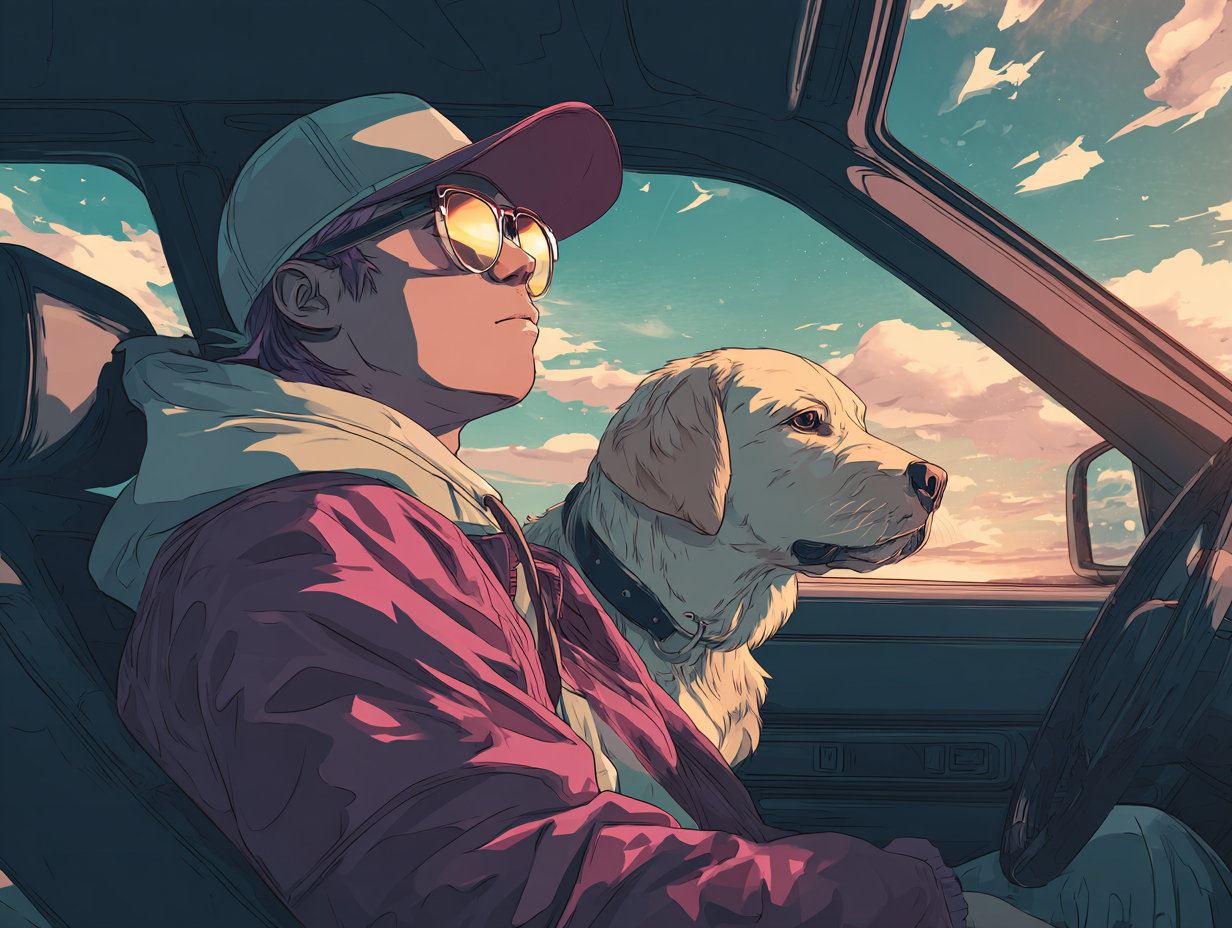Editor Picks
Sorry, Posts you requested could not be found...
latest posts
Does Niagara Falls freeze over in winter? Here’s the truth
Come winter, without fail, you will start to read about how Niagara Falls has frozen, and it looks ethereal to say the least. Then come the photos of one of the world’s most powerful waterfalls, completely frozen over. The reality is far more intriguing. Well, let us burst the bubble – Niagara Falls never fully freezes, no matter how cold it gets. That’s because it’s just an enormous volume of water, over three million litres per second, continuously surging over the edge, generating enough movement and energy to prevent the falls from freezing solid. It just can’t freeze over. But here’s what it can do: It can look stunning! The falls may not freeze but the surroundings can, and freeze they do.
The mist rising from the crashing water freezes on contact with rocks, cliffs, trees, and walkways. Ice accumulates along the edges of the falls and the Niagara River, creating the illusion of a frozen cascade. This partial freezing reshapes the entire landscape, turning Niagara Falls into one of the most spectacular winter sights in North America.
Ice formations create a natural amphitheatre
As the mist from the falls rises and freezes, it gradually builds massive ice structures around the gorge. These frozen formations cling to cliff faces and viewing platforms, growing thicker with each passing cold day. So this actually resembles frozen waves. And sometimes they look like towering walls of ice, sculpted by wind and spray. The drama of the contrast between the smooth, flowing water and the jagged, textured ice is worth witnessing.
Snow transforms the landscape into a winter fairytale
Chasing snow this winter? Add waterfall to the chase and you will get Niagara Falls. Winter snowfall leaves the Niagara region in white, turning the landscape into something dreamy and dramatic at the same time, and dramatic in a good way of course. Snow-covered trees line the riverbanks, and pathways glisten with frost. The view is to die for. For photography enthusiasts, this seasonal palette is one of the best and most rewarding.
Magic of frozen river edges and ice fields
This is what happens: During prolonged cold spells, the Niagara River develops thick ice along its edges, sometimes extending far upstream. Large ice sheets and floes collect near the falls, slowing the river’s surface flow and creating the illusion of a frozen river. But mind you, it’s never completely frozen. Because of these ice buildups, the talk of Niagara freezing over likely began in the first place.
Icy mist creates a shimmering, otherworldly atmosphere
The constant spray rising from the falls freezes almost instantly in winter air, coating everything it touches in fine ice crystals. If the spray touches the trees, expect to see snow-dusted trees. And that is a sight to behold. To say there is a nip in the air would be an understatement. If you thought this was dramatic, wait till you hear the sound of the waterfall.
Winter means unhurried and intimate holiday
Visit Niagara Falls in summer, and the experience can be overwhelming. And by experience we mean the crowd. Come winter, the crowds thin out, allowing you to have an unhurried holiday where you can enjoy all the attractions at your own pace.
What makes you fall in love with a country you visit or you dream of visiting? How to answer this, right? Well, admiration for a country is, more often than not, shaped by far more than tourism or economic strength alone. Factors such as trust in government, quality of life, safety, environmental responsibility, cultural appeal, and global behaviour all play a role in how nations are perceived internationally. Each year, the Reputation Institute measures these perceptions to determine which countries enjoy the strongest global reputations. Let’s look at what the study revealed. Here are the 10 most loved countries in the world in 2025.
Canada
The world loves Canada, and it’s no surprise. According to the report by Reputation Institute, Canada leads the 2025 ranking due to its global image as one of the world’s most welcoming and inclusive societies. It consistently scores high for political stability, safety, public healthcare, education, and social cohesion.
Norway
Norway’s strong reputation is built on transparent governance, economic security, and a high standard of living. The country is admired for its responsible management of natural resources, commitment to environmental protection, and comprehensive social welfare system. Norway’s dramatic landscapes draw in travellers from across the world, and strong human development indicators further enhance its global appeal.
Sweden
Sweden is widely respected for its progressive social policies, innovation-driven economy, and focus on sustainability. The country is seen as a global leader in environmental responsibility, gender equality, and work-life balance. Its reputation also benefits from strong public institutions and a culture that prioritises social well-being.
Switzerland
Switzerland’s reputation rests on neutrality, political stability, and economic resilience. Known for precision, efficiency, and high-quality infrastructure, the country scores highly for governance and safety. Its alpine scenery is loved by travellers, and financial credibility, and strong public services is loved and admired by those looking to spend longer time in the country. All these contribute to its image as one of the most reliable and well-managed nations in the world.
Australia
Australia’s high quality of life, strong education system, and relaxed lifestyle are the reasons why we find the country in the list. The country is admired for its openness, cultural diversity, and world-famous natural attractions. Australia’s stable economy and reputation as a desirable destination for both travel and migration strengthen its standing in global perception rankings.
Finland
Of course, the happiest country in the world has to be on the list of most loved countries. Finland continues to be admired for its education system, social trust, and governance model. Often ranked among the happiest countries in the world, Finland is known for its low corruption levels, strong public institutions, and focus on citizen well-being.
New Zealand
Lakes, grasslands, Lord of the Rings, sheeps, what’s not to love when it comes to New Zealand? The country’s stunning natural landscapes, environmental consciousness, and approachable governance always win hearts. The country’s emphasis on sustainability and social cohesion contributes to its positive global image. It is also seen as safe, peaceful, and well-governed, making it highly respected internationally.
Denmark
Denmark is known for social equality, happiness, and urban liveability. It is admired for its strong welfare system, green energy leadership, and people-centric urban planning. With so many facilities around for residents and travellers, it’s easy to fall in love with Denmark. The country’s reputation is closely linked to low inequality, and a high quality of everyday life.
Netherlands
The Netherlands, recognised for its open society, innovation, and efficient governance, has always been one of the most preferred holiday destinations, not just for the young, but for the elderly as well. The country’s reputation is due to progressive social values, strong infrastructure, and a business-friendly environment. The country’s role in global trade, diplomacy, and sustainable development adds to its international respect.
Belgium
Belgium on the list is expected. The country’s strengths lie in healthcare, governance, and cultural heritage. The country is a key hub for European Union institutions, and also plays an important role in international diplomacy. Its reputation is also supported by high living standards and a strong public services network.
The holiday season is notorious for its travel chaos, and when you add a pet to the mix, the stress can increase significantly. Whether traveling by car, train, or plane, taking your pet along requires careful planning and attention to detail. As the holiday season approaches, pet owners must manage the complexities of travel logistics while ensuring their pets remain comfortable and safe.
Studies show that many pet owners opt to travel with their pets during the holiday season. However, navigating the journey with a pet, especially during a busy travel period, requires preparation and an understanding of the necessary steps. Proper research and planning can lead to a much smoother experience for both pets and their owners.
Understanding Pet Travel Regulations and Requirements
Whether you’re flying, driving, or taking a train, it’s important to familiarise yourself with travel regulations and requirements for pets. Different modes of travel and destinations require different preparations.
For air travel, regulations vary depending on the airline and the destination. Many airlines require pets to be in IATA-approved carriers that are sized appropriately for your pet. Airlines also have specific limits on the number of pets allowed in the cabin, so booking early is crucial. According to the International Air Transport Association (IATA), it’s also important to ensure that your pet’s carrier is properly ventilated and secure to avoid discomfort during the flight.
When travelling internationally, ensure your pet has the necessary health certificates and vaccinations. The Centers for Disease Control and Prevention (CDC) and the U.S. Department of Agriculture (USDA) require specific paperwork, including rabies vaccinations and pet health certificates, for pets entering the United States.
Preparing for Car Travel with Your Pet
For many pet owners, driving to a holiday destination is a preferred option, as it provides more control over the journey. However, driving with a pet requires careful preparation to ensure their safety and comfort. The American Veterinary Medical Association (AVMA) recommends that pets be secured in a proper carrier or with a seatbelt harness in the back seat to prevent injury or distraction during travel.
It is also important to take regular breaks for your pet to stretch, relieve themselves, and stay hydrated. When travelling long distances, pack a dedicated “pet go-bag” with food, treats, medications, waste bags, and a leash. Having everything you need on hand helps to minimise stress during travel.
Flying with Your Pet: Tips for a Comfortable Journey
Flying with pets can be one of the most challenging aspects of holiday travel. For smaller pets, travelling in the cabin with their owner is the best option, as it is typically less stressful than cargo hold travel. Airlines often provide specific guidelines on the size and weight limits for pets in the cabin. Always confirm your pet’s booking as early as possible, as airlines usually have a cap on the number of pets allowed per flight.
For longer flights, choosing non-stop routes can reduce travel time and layovers. Avoid booking flights during peak hours to minimise delays. Additionally, many experts suggest travelling in the morning, as early flights tend to experience fewer delays.
To prepare your pet for the flight, crate-training is essential. Ensure your pet is familiar with their carrier before the flight, making the transition smoother on the day of travel. A comfortable, well-ventilated crate with familiar bedding and a few treats can help keep your pet calm during the journey.
Researching Pet-Friendly Lodging
Once you arrive at your destination, the next consideration is accommodation. Not all hotels or vacation rentals accept pets, so it’s essential to research pet-friendly options well in advance. Many hotels charge extra fees for pets, and some impose breed or size restrictions, so reading the fine print is essential.
Certain destinations have dedicated pet-friendly lodgings, but it is always wise to confirm their pet policies before booking. Additionally, ensure that your pet is comfortable during the stay, some hotels require pets to be crated if left unattended in the room.
Managing Pet Stress During Travel
Travel can be overwhelming for pets, particularly when they are placed in unfamiliar environments or situations. To reduce stress, try to maintain your pet’s routine as much as possible. Feed and exercise them at regular times, and bring familiar items like their favourite blanket or toy to provide comfort.
Experts recommend using calming aids such as pheromone sprays or calming collars to help reduce anxiety during the journey. A quiet room for the pet to relax in during hectic travel preparations can also help.
A Well-Prepared Pet is a Happy Traveller
Managing the logistics of holiday travel with pets requires a combination of careful planning, proper documentation, and making sure that your pet’s needs are met throughout the journey. With these tips in mind, pet owners can make their travels smoother and more enjoyable for both themselves and their pets. Preparing early, booking travel in advance, and selecting pet-friendly accommodations are key to a stress-free holiday season.
By prioritising your pet’s comfort, safety, and well-being during travel, holiday trips can become an enjoyable experience that both owners and pets will cherish. Happy holidays and safe travels!
Holiday travel often disrupts routines, but mindful choices around food, sleep, movement and stress can help you stay well throughout your trip
The holidays are a time for adventure, relaxation and making memories. But excitement, indulgent food and disrupted routines can take a toll on health, leaving travellers tired or unwell. Doctors say a few simple habits can help safeguard wellbeing without taking away from the fun.
Hydration matters more than you think
Drinking enough water while travelling is critical. “Indoor heating, sweets, caffeine and alcohol all promote dehydration. Dehydration worsens fatigue, headaches, skin dryness and constipation,” says Dr Nikitha Narayanan, oral pathology and microbiology specialist at iCliniq.
Dehydration also reduces urine output, slowing the body’s ability to flush out waste products and allowing toxins to build up. Carrying a refillable water bottle and sipping regularly through the day helps maintain energy levels and digestion. Doctors advise avoiding the habit of replacing water entirely with sugary drinks or excess caffeine, which can worsen dehydration.
Enjoy local food without upsetting your gut
Holiday food is a highlight of travel, but sudden dietary changes can upset the stomach. “You need to control timing, portions and balance out your plate,” Dr Narayanan says.
Starting meals with protein and vegetables, sharing desserts instead of eating full portions, and limiting heavily processed snacks can help. When travelling in places where food or water hygiene is uncertain, choosing freshly cooked meals, drinking bottled water and avoiding ice made from unknown sources can significantly reduce the risk of foodborne illness.
Sleep is not optional
Travel often disrupts sleep schedules, but rest is essential for immunity, mood and recovery. Poor sleep raises stress hormones and increases vulnerability to infections.
“Rest is not laziness. It is essential for nervous system recovery,” Dr Narayanan says. Keeping sleep and wake times as regular as possible, avoiding heavy meals or alcohol late at night, and getting daylight exposure through short walks can help regulate the body clock, especially after long journeys.
Movement keeps fatigue away
Even on relaxed holidays, light physical activity plays a key role in preventing sluggishness. Gentle walking, sightseeing on foot, stretching or taking the stairs improves circulation, boosts mood and supports better sleep.
Doctors say consistency matters more than intensity. Regular, low-effort movement helps counter the effects of long flights, car journeys and extended sitting.
Plan ahead with essentials
A simple travel health kit can prevent small issues from becoming major disruptions. Hand sanitiser, basic first-aid supplies and regular medications should be packed in advance. Prescriptions should be refilled before departure, and international travellers may need to check vaccination or preventive medication requirements.
Dressing appropriately for the destination’s climate also reduces the risk of sunburn, cold-related illness or altitude-related problems.
Slow down to truly switch off
Good health habits go beyond physical care. Managing stress and pacing your holiday schedule are just as important. Avoid overbooking your days and build in time to rest between excursions. Short breaks, deep breathing and moments of silence can help you enjoy travel without feeling drained.
Holiday stress is often fuelled by social pressure, family expectations, financial strain and emotional overload. Protecting mental health during travel means setting boundaries without guilt, resisting the urge to overcommit and limiting social media comparison.



